Saltmarshes are coastal wetlands that are flooded and drained by saltwater brought in by tides. There are two types of them in the world depending on their distribution. Temperate saltmarshes are grass dominant upper coastal inter-tidal zones between land and the sea which are distributed throughout coastal areas of countries with a temperate climate such as the United State of America, Canada, France, and South Korea while the tropical saltmarshes are shrub dominant coastal intertidal zones margined by the sea or sometimes mangrove ecosystems and the terrestrial area. They are distributed in countries with a tropical climate such as India, Sri Lanka, Brazil, and a few Southeast Asian countries.
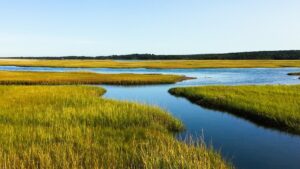
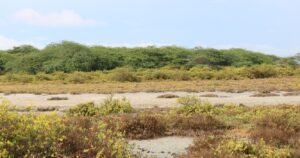
Sri Lanka, one of the most biodiversity-rich countries in the world with various types of habitats that are completely different from each other. Here, salt marshes are distributed only in the coastal area of the North, North-West, and South-East where the climate is characterized by a long dry season. Most of these areas receive little or no rain for about five months from April to August or September. Of the total area of 23,819 Ha of salt marshes in Sri Lanka, 6,591.8 Ha are distributed in the Mannar district and the Vankalai saltmarsh acts a major role there. Mannar is a district in the Northern province, Arid zone in Sri Lanka. Due to its extremely warm climate conditions, it is home to unique floral and faunal biodiversity with various types of habitats. The coast of Mannar is connected by the Polk-bay of the Indian ocean. Attributable to the neighbour’s relatively larger landmass of India, the area of Polk Bay has only 5.8 m of average depth and less in tidal actions. These special conditions in this area lead to different types of coast-related ecosystems such as estuaries, lagoons, bays, mangroves, and saltmarshes. Estuaries are the area where few rivers meet the saltwater of oceans. They are highly productive, dynamic, and ecologically critical ecosystems to other marine systems. Lagoons are brackish coastal water bodies, either permanently separated from the sea or connected with the sea only during part of the year. The Vankalai lagoon was named a bird sanctuary in the year 2008. Due to the shallowness of the area of the Gulf of Mannar, it is an ideal habitat for seagrass meadows. All in all, the most special habitat of the Mannar area is the salt marshes.
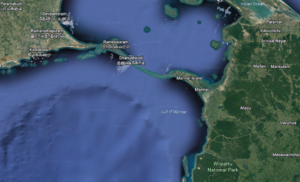

It is consisting of nearly 4000 ha and is mainly a shrub-dominant tropical saltmarsh. This ecosystem has a unique flora and fauna diversity with adaptations to its harsh conditions especially high salinity, high sunlight, and high temperature. The substratum is mainly consisting of mud or sandy, sometimes peat that is made up of decaying plant matter. Hence there is no canopy coverage or larger scaled trees, sunlight directly falls on the small shrubs and herbs. So, the plant species which are unique to saltmarsh habitats show special characteristic adaptations to survive like fleshy leaves. There is no canopy coverage or large-scaled trees in this area but only small shrubs and herbs. Most abundant plant species were Suaeda martima, Suaeda vermiculata, Suaeda monoica and Halosarcia indica. S. maritima, S. vermiculata and H. indica are small herbs with a maximum height of less than afoot. But, S. monica can grow up to 2 m. Though tropical saltmarshes do not show zonation like temperate salt marshes, in Vankalai saltmarshes, partially zonation could be seen. S. vermiculata, S. maritima and H. indica are distributed all over the habitat while S. monoica only grows on edges. H. indica were the most abundant plant species. All of them show special adaptations to survive in harsh conditions such as strong sunlight, high temperature, waterlogged soil and high salinity. Their leaves are fleshy to avoid dehydration and to lie dormant when water is unavailable. S. vermiculata is known to exhibit a wide range of pigment colouration from dark green, light green, yellow, brown, orange to red. It might be depending on the salinity stress (Taibi et al. 2016) but in the Vankalai lagoon, there were different colourations in nearby S. vermiculata plants. While three species are having fleshy stems, S. monoica consists of woody stems. It might be a reason for their unusual height compared to other saltmarsh plants.
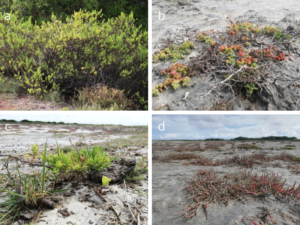
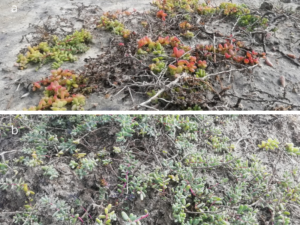
Heliotropium curassavicum (Salt heliotrope), Sesuvium portulacastrum (Sea purslane), and a few grass species are the other plant species that are distributed in the middle part of the Vankalai saltmarsh while the edges were dominated by Acacia eburnea, Calotropis gigantea, and Prosopis juliflora. Both Halosarcia carassivicum and Sesuvium portulacastrum are succulent plant species with adaptations to high salinity habitats. Grass competes with Suaeda spp. And Halosarcia indica for sunlight and space. Acacia eburnea is a plant in the African region and was introduced to Sri Lanka. It has sharp and long spines and a symbiotic relationship with ants to protect from herbivores.
Prosopis juliflora is a plant that is native to South America and Mexico. It is introduced to Sri Lanka and now become one of the worst invasive alien species in Sri Lanka (MoE, 2012). It is distributed throughout Bundala, Hambantota and Mannar areas and eliminating the native plants rapidly. In Vankalai saltmarsh, Prosopis juliflora can be only seen on the edges of the habitat. Hence, they are not able to survive in water-logged and highly saline water. Tropical saltmarshes are inundated by tides seasonally; therefore, P. juliflora cannot invade the habitat completely. But due to un-planned road constructions across saltmarshes, the land-side area of the habitat will not be inundated by tides. Because, when building roads, the soil became more compact. This would be a good chance to P. juliflora to invade the saltmarsh habitats completely. Due to having thrones localities don’t use it as wood and herbivores like cattle don’t feed on it. These plants can be used for shading when maintained well. Avoiding un-planned road constructions might be the best way to protect saltmarsh habitats from the invading of P. juliflora.
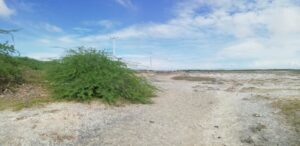
Saltmarsh habitats are both ecologically and economically and ecologically important ecosystems. When it is inundated by tides, larvae and juveniles of various species of marine creatures are washed into the saltmarsh habitats and it acts as a good nursery and feeding ground for them due to the formation of highly nutritious, nitrogen-fixing organisms rich, algal mat on the water surface in the rainy season. Chanos chanos (Milk-fish) is the most abundant fish species in this period of time and they are an economically important organism that is used as bait when fishing. During the inundation time, saltmarsh habitats are rich in crustaceans, crustacean larvae, fish larvae, shrimps, aquatic insects and molluscs. Therefore, these saltmarsh habitats in Sri Lanka, especially Vankalai saltmarsh is a major stop-over for migratory birds which are travelled along the Central-Asian flyway from Russia, Northern India, West Europe and the upper part of Middle-east Asia. Phoenicopterus roseus (Greater Flamingo), Actitis hypoleucos (Common Sandpiper), Dromas ardeola (Crab plover), Himantopus himantopus (Black-Winged Stilt), Anas acuta (Northern Pintail), and Anas querquedula (Garganey) are the some of them. The main food source of P. roseus, Artemia can be easily found in saltmarshes this period of time (October – December). Hence, a group of about 2000 individuals of migratory greater flamingos come to Vankalai each year. (There is also a resident group of Greater Flamingos in Sri Lanka). Halcyon smyrnensis (White-throated Kingfisher), Bubulcus ibis (Cattle Egret), Egretta garzetta (Little Egret), and Chlidonias hybrid (Whiskered Tern) are the most common native birds in this habitat. Haliastur indus (Brahminy Kite) is the most abundant bird of prey here.
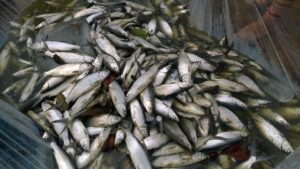
Saltmarsh habitats are used as grazing grounds for domestic cattle (Boss sp.) and for donkeys (Equus africana) by live-stock owned localities. It is a benefit for the ecosystem because cattle and donkeys mainly feed on grass species that compete with saltmarsh plants and it helps Suaeda spp. and Halosarcia indica to grow easily. It is a mutual relationship that is benefited both the ecosystem and the herbivores.
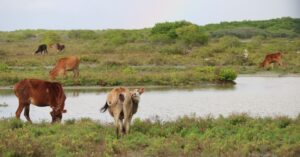
Fun Fact:
Most of the time, a mangrove ecosystem can be seen in between the sea and the tropical saltmarsh habitat. Ex: Vankalai Saltmarsh. Therefore, a few flora species of mangroves can be seen along with saltmarsh plants. Rhizophora mucronata, Bruguira sp., Excoecaria agallocha, Sonneratia sp., and Avicennia marina are the most common mangrove species in Vankalai saltmarsh
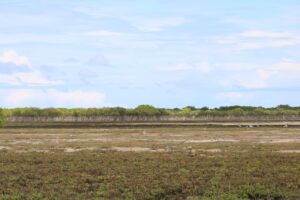
At present days, these wetlands face numerous threats and the area is rapidly decreasing day by day. Spreading of alien invasive plants like P. juliflora, dumping of non-degradable garbage, un-planned constructions such as buildings and roads, prawn farming, using illegal fishing methods, illegal prawn farming and filling of wetlands are the major ones. Conducting awareness programs for localities, avoiding un-planned constructions and rule laws for environmental pollution would be the best ways to protect these valuable habitats for future generations. Otherwise, the destruction of saltmarsh ecosystems will lead to lots of ecological and economic disasters in the near future.
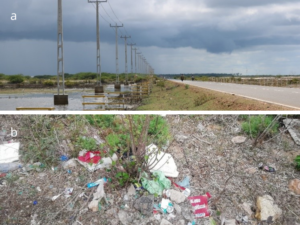
Special thanks go to;
Nevinda Abeysinghe: https://nevchat26.blogspot.com
Kumudu Wijesooriya: https://www.instagram.com/kumudu_b_wijesooriya_macro/?hl=en
Reference:
Abeywickrama, B.A. and Arulgnanam, P., 1993. The coastal plants of Sri Lanka-Part I (Salt marsh plants). MAB Publication: No. 20.
Amarasinghe, M.D. and Perera, K.A.R.S., 2017. Ecological biogeography of mangroves in Sri Lanka. Ceylon Journal of Science, 46(5), p.119.
El Ghazali, G.E., 2020. Suaeda vermiculata Forssk. ex JF Gmel.: Structural Characteristics and Adaptations to Salinity and Drought: A Review. International Journal of Sciences, 9(02), pp.28-33.
Lesage, V., Gosselin, J.F., Hammill, M., Kingsley, M.C. and Lawson, J., 2007. Ecologically and Biologically Significant Areas (EBSAs) in the Estuary and Gulf of St. Lawrence, a Marine Mammal Perspective (p. 92). Canadian Science Advisory Secretariat.
Miththapala, Sriyanie (2012). The Gulf of Mannar and its surroundings: A resource book
for teachers in the Mannar District. IUCN Sri Lanka Office, Colombo.
MOE (2012). The National Red List 2012 of Sri Lanka; Conservation Status of the Fauna and
Flora. Colombo, Sri Lanka: Ministry of Environment.
Pemadasa, M.A., Balasubramaniam, S., Wijewansa, H.G. and Amarasinghe, L., 1979. The ecology of a saltmarsh in Sri Lanka. The Journal of Ecology, pp.41-63.
Ranawana, K.B., 2017. Mangroves of Sri Lanka. Publication of Seacology‐Sudeesa Mangrove. Museum, 1.
Ratnasooriya, W.D., Pathirana, R.N., Dissanayake, A.S., Samanmali, B.L.C. and Desman, P.K., 2016. Evaluation of invitro sun screen activities of salt marshy plants Suaeda monoica, Suaeda maritima and Halosarcia indica. International Journal of Pharmaceutical Research & Allied Sciences, 5(2).
Wijesundara C.S. (et al) Population size and movements of the Greater Flamingo
(Phoenicopterus roseus) in the Jaffna peninsula, Sri Lanka: Results from a long-term
study.






